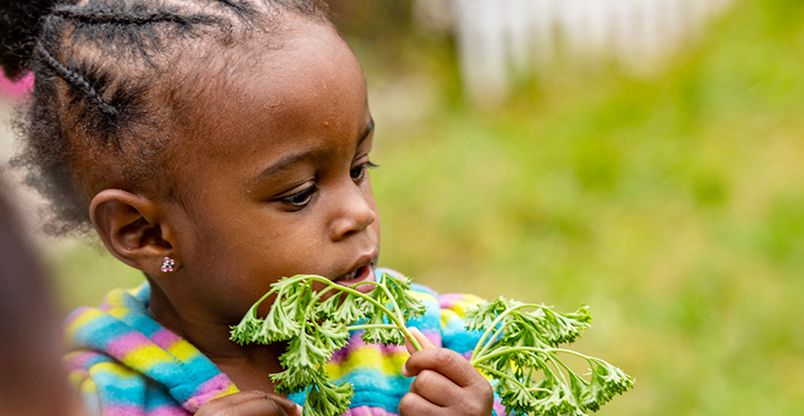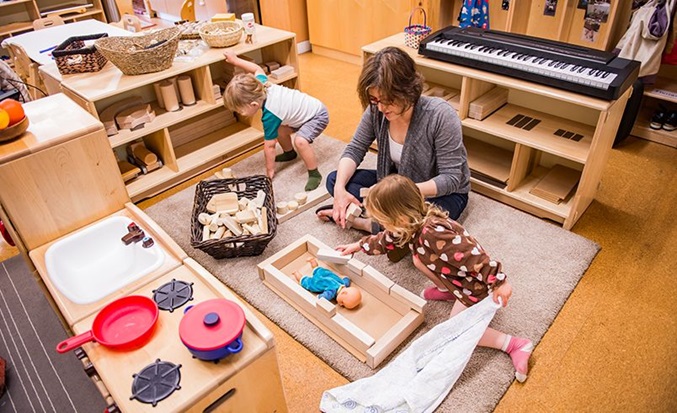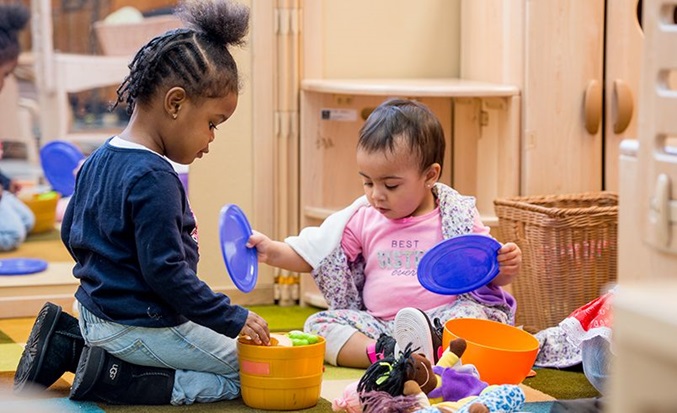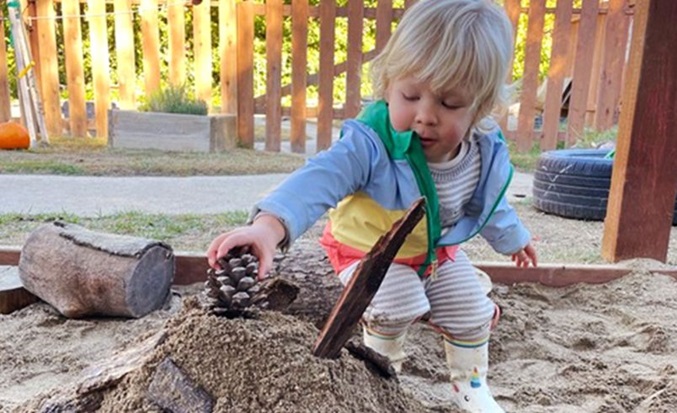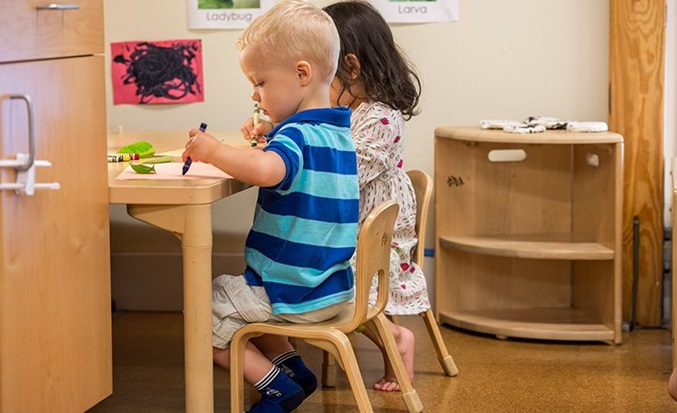Toddlers as Investigators
Understanding Emergent Curriculum
| May 2023Understanding Toddler’s Inquiry
Two-year-old Fiona is very interested in the small indoor sink that is used for hand washing. Ana, her teacher, observes Fiona’s fascination with bubbles and sponges. Since the sink inside has a specific purpose, Ana redirects Fiona to the water table and adds liquid soap with sponges and dishes for Fiona to explore. Ana is responsive to Fiona’s curiosity and need for autonomy, while at the same time teaching respectful boundaries about the environment.
All toddlers, like Fiona, are fueled by curiosity and full of questions about the world. Toddler programs need to provide many opportunities for inquiry, exploration, and play. Through observation, reflection, interpretation, and planning, teachers can gain an understanding of the children’s curiosities. With this knowledge, educators can thoughtfully plan curriculums and environments that support all the areas of a toddler’s development.
The emergent curriculum provides a method of planning based on children’s inquiries that is particularly sensitive to and respectful of this critical stage of development. Toddlers bring their inquiries and questions to the teachers, which in turn, supports the teachers’ curriculum planning creating a partnership in the learning process.
Learning Through Play
It is essential for educators to understand the value of play in toddlers’ learning. Play is self-initiated and allows children to be actively engaged, taking charge of their own learning in all domains. As Elizabeth Jones and John Nimmo urged decades ago in their foundational book, Emergent Curriculum, play allows toddlers plenty of active participation with their environment as well as the opportunity to investigate their ideas. (1994). When toddlers play, they make sense of their questions through the physical environment while interacting with objects, often with repetition, to develop an understanding of how things work. They use open-ended materials such as sand, dirt, blocks, and water to find a deeper meaning to their questions. When the materials promote problem solving, imaginative play, scientific inquiry, and sensory exploration, they become resources for rich learning.
In addition, toddlers learn through their physical bodies by climbing, jumping, running, and other large-motor activities (Maguire-Fong. 2015). Outdoor play supports whole body development. When toddlers play outside, they become inventive, explore the environment at their own pace, and begin the process of taking initiative. Children who play outdoors regularly are more curious, self-directed, and are likely to have longer attention with a task (Louv 2005).
Play also offers toddlers opportunities for peer scaffolding, in which a more experienced peer supports or extends the knowledge of another. One child might have the language to express an idea to a nonverbal peer, creating a new opportunity for language development. As they play and interact with people in their environment, toddlers learn about interpersonal relationships and begin to understand.
Breaking Away from Scripts
Unfortunately, thematic curriculums designed for toddlers have developed “scripts”, based around predetermined topics chosen by teachers and schools. Responsive curriculums, on the other hand, allow teachers to break away from tight scripts and respond to toddlers’ current interests, in order to meet their needs.
Toddlers’ most effective and meaningful learning takes place when the presented topic or idea is of interest to the child. For example, at one toddler program, the teachers observe the children’s desire to cook and create mixtures using plants and raw materials. The teachers respond by adding spices and edible dried flowers to invite the children to explore the process of scientific inquiry.
Two-year-old Naomi finds delight in this exploration and invites another toddler, Irene, to join. More ingredients are added, mixed, and ground. The two toddlers talk about their creation.
“It’s cake!”
“No, it’s miso soup!”
This activity extends in many directions for a long part of the morning and reflects their desire to stay involved in the activity and further their investigation of spices.
Natural materials are intriguing to toddlers and support healthy dispositions for learning.
The Art of listening: Toddler’s Inquiries
Toddlers keep up a nonverbal dialogue, and teachers need to rely heavily on observing and listening to them in order to give them what they need. This starts with the practice of observation and reflection and leads to developing an understanding of the children’s thinking.
Toddlers’ inquiries and questions are made visible through their actions, gestures, and expressions, as they interact with their environment and one another. Teachers keep these observations and stories in mind by documenting, communicating, and interpreting them together. This serves as tools for later planning and sharing with families, educators, and the community at large.
Through listening to children, teachers gain insight into their curiosities and knowledge. Active listening strengthens teachers’ understanding of children, prompting important questions such as:
What are the toddlers curious about?
What are their interests?
What are they trying to understand?
What do the toddlers wonder about their environment?
What are their developing theories?
What can we learn from them?
How do we understand toddlers’ inquiries even when they lack the language to communicate?
What specific toddler interests do we choose for our planning?
These questions will lead teachers to important information in setting up the environment and providing rich opportunities for learning.
For example, teachers may observe how toddlers spend a great deal of time pouring, dumping, and transferring materials from one place to another. Some teachers may view this as an annoyance or a behavioral issue that needs to be addressed and discouraged. But for toddlers, this is a rich opportunity for learning. When setting up a toddler environment, teachers can use the interest of pouring in their activity planning. Different sized containers: large, recycled bottles, and small cups give toddlers the opportunity to explore pouring and dumping. The concept of transferring becomes planning topic in curriculum.
Honoring Toddlers’ Unique Development
During the first three years of life, children’s brains develop rapidly. Children from ages birth to three experience extensive changes in every area of their development. This includes social and emotional growth, motor skills, language, and cognitive growth. This sensitive stage of development gives teachers the opportunity to create a curriculum that focuses on the specific needs of a toddler (Hyson and Tomlinson 2021).
Toddlers experience emotions intensely and are acutely aware of their environment. Toddlers are developing ways to regulate their emotional impulses and find healthy outlets for self-expression. They also become interested in relationships and begin to build trust in others and their environment.
As teachers observe toddlers’ sensitive needs, they can provide children with the appropriate tools for self-regulation. For instance, if a child is going through a difficult separation process after their family leaves, teachers can integrate strategies and tools that are emotionally supportive to toddlers’ development as they work through this stage. Setting up a library with books that address feelings and separation gives children resources to validate their feelings. Likewise, having an area for toddlers to experiment with writing (scribbling), or dictating messages to their families gives space for self-expression.
Putting it all Together
It takes thoughtful reflection and careful planning to provide safe, stimulating environments for toddlers. Teachers need space and time to organize ideas, share and discuss their observations, reflect on toddlers’ questions, and plan the curriculum and environment that build on the toddlers’ interests. Finding time for teachers to meet can be an obstacle in developing curriculum. But determined educators find time for staff members to meet and discuss responsive methods to engage toddlers' emerging interests.
Emergent curriculum is a teaching approach that responds to toddlers’ developmental abilities and current interests, allowing them to partner in the learning process. Through engaging in their own learning toddlers become curious and enthusiastic life-long learners.
References:
Stacey, Susan. 2009. Emergent Curriculum in Early Childhood Settings: From Theory to Practice. St. Paul, MN: Redleaf Press.
Hyson, Marilou, and Heather Biggar Tomlinson. 2014. The Early Years Matter. New York: Teachers College Press; Washington, DC: National Association for Young Children.
Jones, Elizabeth, and John Nimmo. 1994. Emergent Curriculum. Washington, DC: National Association for the Education of Young Children.

